Updated: 18-Feb-2020
Gottlieb Daimler (1834-1900) shows his first single-cylinder engine in 1889 and it is not until three or four years later that he presents a car vee-engine.
-Certainly the license of this engine was acquired by M.A Peugeot, who gave it to Levassor, from Panhard et Levassor, for using it in their cars too.
-We were sent a photograph of the year 1888 in which a certain Mr. Wolfert uses a Daimler engine for the first time to propel his dirigible.
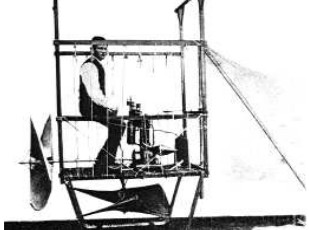
"Chassis with Mr. Wolfert"
-We see that the engine is single-cylinder and outside the chassis there is a canvas working as a rudder. It also has a propeller for longitudinal displacements and another to ascend and descend. Theoretically the maneuvers could be of all type.

"Daimler 1"
-In 1899 Daimler already has an inline upright 4-cylinder engine, and the NL-1 version of this engine is installed on the first German Zeppelin, the LZ-1 (Luftschiffes-Zeppelin).
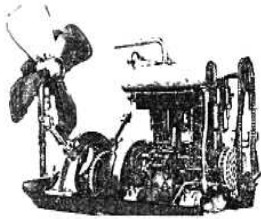
"Daimler NL-1"
-The NL-1 had 4 cylinders and gave 16 CV at 700 rpm.
-Daimler named its engines and cars as "Mercedes"
Anecdote:
Mercedes Jellinek was the daughter of Emil Jellinek who, after the death of Gottlieb Daimler, became a member of the board of directors for Daimler Motoren Gesellschaft (DMG) between 1900 and 1909. In 1902 he asked to name the car brand with the name of his daughter. It turns out that for commercial interests it was considered appropriate to put a neutral name to these German cars.
-Over time Daimler Motoren Gesellschaft was related to Benz.
-It was from 1926 after the relaxation of the armistice conditions when they became a single company for aviation engines (Daimler-Mercedes-Benz), instead of going separately.
-During the WWI, we have engines with the name of Daimler, Mercedes, Benz, separately and some mixed like Daimler-Mercedes, etc.
-Chronologically, the main aero engines of Daimler appeared in 1906-1908 with those installed on the Zeppelin LZ-6 and the LZ-7, designed for this purpose. They were the four-cylinder 4J4Ls that gave 120 CV at 1,200 rpm.
-In 1909, the D4F, also a 4-cylinder, gave 59 hp at 1400 rpm. In 1910, the 8-cylinder Typ J8-4, was installed on the Shutte-Lanz SL-1. Also in 1910 appears the E4F with 4 cylinders giving 64 CV at 1200 rpm.

"Daimler E4UF"
-The E4UF is the same engine as above but inverted, It has 6.3 lts. of displacement and gear.
-In 1912, appeared the C4F, which was also a 4-cylinder that gave 100 CV at 1,370 rpm.
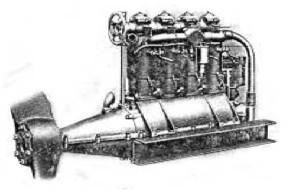
"C4F"
-Towards 1913, the D-I and D-II appeared with 6 cylinders giving 100 CV and 120 CV respectively.
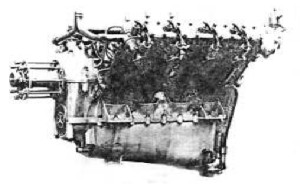
"D-IIIb"
-There was an exceptional engine for its formula of 8 cylinders in line, the D-IV. This engine had many gear and vibration problems, that prevented its desired success. Year 1915.
-We see in the details of both sides the use of the twin cylinders and gear.
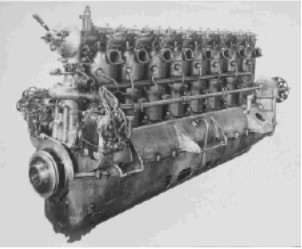
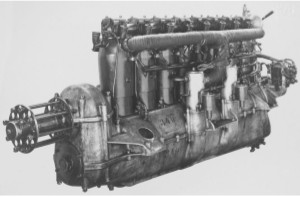
"D-IV, on both sides"
-However, we present the complete D-IV engine in two photographs: one from the Polytechnic in Turin where its name is related to Mercedes, as Daimler-Mercedes D-IV.
-The other as Mercedes only, or as the Mercedes D-IV. And that is how it is referred to in its production line. It gave 220 CV.
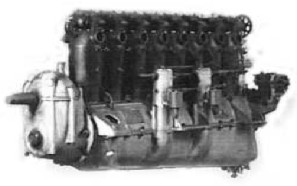
"Daimler D-IV"

"Daimler (Mercedes) D-IV"
-In 1916 the 6-cylinder D-VIa came out. It gave 275 CV at 1,500 rpm. The D-VI had 18 cylinders in W, and gave 500 CV with 44 lts. of displacement.
-Daimler engines were also built in Austria as "Austro-Daimler".
From Appendix 6: The brand's engine descriptions are already in the main text, as well as its relationship with Benz and Mercedes.
-We now provide additional information to have a better and fairer idea about the brand.
-The first Daimler engine is from 1884 and was a static, single-cylinder and yet light for being stationary.
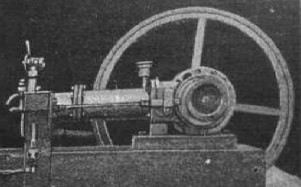
"Daimler's first engine"
-This first engine had the following German patent number: 28022.
-More useful was the two-cylinder engine for vehicles of which we also show a picture.

"The Daimler two-cylinder"

"A motor for Daimler airships"
-This engine already appears in the main text, but we mention it here because in a documentation it is identified as the "Ballon-Daimler". This engine gave 240 CV at 1,100 rpm and had 8 inline upright cylinders.
-The illustration above shows it from both sides.
-The NL-1 that is exhibited at the Museum of Munich reveals some interesting characteristics:
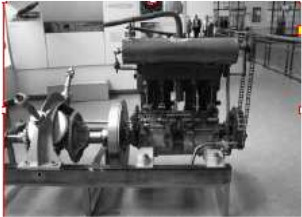
"The NL-1 for airships"
A coupler driven by a fork engages a planetary gear for the forward or the other for the reverse gear.

“Daimler NL-1, reversing lever close-up”
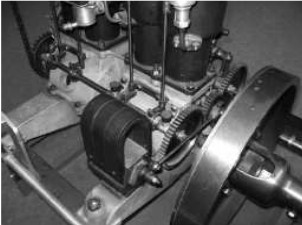
“Daimler NL-1, Magneto and ignition camshaft”
-The magneto is connected to the crankshaft by an eccentric and a connecting rod that makes a rocking movement. This causes the interruptions in the flow lines of the three double magnetos, producing an alternate current.
-It is sent to a high tension coil with four outputs, one for each spark plug, (see the spiral wire in the same engine as the main text). The circuit is closed to ground by each spark plug at the right time. Such a system - with differences - is that used by the Wright brothers in their Flyer.
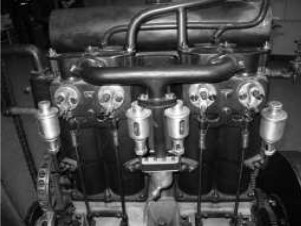
"View of the NL-1 on the intake side"
-The four clear caps on the cylinder heads have their central electrode terminal and another lower one that is "touched" by the rod that rises from the ignition camshaft. We see the horizontal coil with four terminals.
-It has a curious cylinder lubricating system by four oil dispensers. It seems that the intake valves are automatic.
-On the other side, the exhaust valve lift system - or stroke variator - is adjustable to be separated from its overhangs. A complicated mechanism whose purpose is still under study by the author. The chain driven top gear is for the fan.
-Some photos of an E4F have been located at the Museum of Munich too. That does not appear in the main text. Courtesy of JGB from the Association of Friends of the Air Museum at "Cuatro Vientos Airport". (Asociación de Amigos del Museo del Aire de Cuatro Vientos)
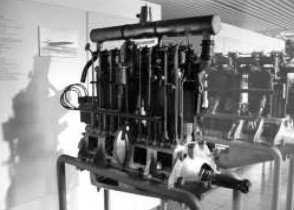
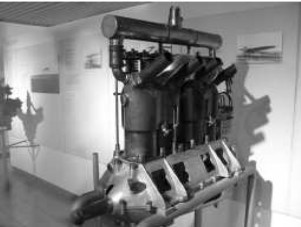
"The E4F, known as Daimler-Mercedes"

“Curious magneto position on the Daimler E4F”
From Appendix 9: We collected information from Daimler with the oil cooling system in sight.
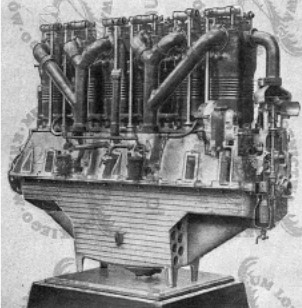
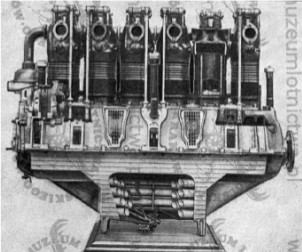
“Two photos with the oil system” (PiP=pl)
-The sump casing has side holes with air ducts that cross it longitudinally, thus cooling the oil.
-It is clearly seen in the second photograph.
-New logo recovered from this prestigious brand.
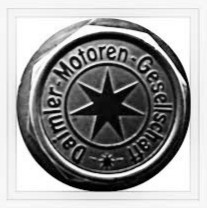
"Brand also known as D-M-G"

“Daimler in Friedrichshafen”
From Appendix 10: We have a sectioned diagram of the Daimler engine from 1897 with two upright cylinders, which could be the prototype for the next ones.
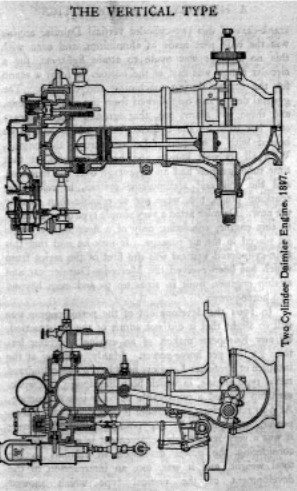
"Daimler with two upright cylinders"
Engines of DAIMLER
Model: 4J4L
Arquitecture: 4-cylinder In-line
Cooling:
Total Displacement:
Bore / Stroke:
Power: 120 CV @ 1200 rpm
Weight:
Model: C4F
Arquitecture: 4-cylinder In-line
Cooling:
Total Displacement:
Bore / Stroke:
Power: 100 CV @ 1370 rpm
Weight:

"Daimler C4F"
Model: D-I
Arquitecture: 6-cylinder In-line
Cooling:
Total Displacement:
Bore / Stroke:
Power: 100 CV @ rpm
Weight:

"Daimler 1 engine"
Model: D-II
Arquitecture: 6-cylinder In-line
Cooling:
Total Displacement:
Bore / Stroke:
Power: 120 CV @ rpm
Weight:
Model: D-III
Arquitecture: 6-cylinder In-line
Cooling:
Total Displacement:
Bore / Stroke:
Power: @ rpm
Weight:
Model: D-IIIa
Arquitecture: 6-cylinder In-line
Cooling:
Total Displacement:
Bore / Stroke:
Power: @ rpm
Weight:
Model: D-IIIb
Arquitecture: 6-cylinder In-line
Cooling:
Total Displacement:
Bore / Stroke:
Power: @ rpm
Weight:

"Daimler-IIIb"
Model: D-IV
Arquitecture: 8-cylinder In-line
Cooling:
Total Displacement:
Bore / Stroke:
Power: 220 CV @ rpm
Weight:

"Daimler D-IV, left-front view"
Model: D-IVa
Arquitecture: 6-cylinder In-line
Cooling:
Total Displacement:
Bore / Stroke:
Power: 275 CV @ 1500 rpm
Weight:
Model: D-VI
Arquitecture: 18-cylinder W-engine
Cooling:
Total Displacement: 44 Ltr.
Bore / Stroke:
Power: 500 CV @ rpm
Weight:
Model: D4F
Arquitecture: 4-cylinder In-line
Cooling:
Total Displacement:
Bore / Stroke:
Power: 59 CV @ 1400 rpm
Weight:
Model: Daimler 1897, 2 upright cyl.
Arquitecture: 2-cylinder In-line
Cooling:
Total Displacement:
Bore / Stroke:
Power: @ rpm
Weight:

"Daimler two-cylinder engine"
Model: E4F
Arquitecture: 4-cylinder In-line
Cooling:
Total Displacement:
Bore / Stroke:
Power: 64 CV @ 1200 rpm
Weight:

"Curious magneto position on the Daimler E4F"
Model: E4UF
Arquitecture: 4-cylinder In line inverted
Cooling:
Total Displacement: 6.3 Ltr.
Bore / Stroke:
Power: 64 CV @ 1200 rpm
Weight:

"Daimler E4UF"
Model: J8-4
Arquitecture: 8-cylinder In-line
Cooling:
Total Displacement:
Bore / Stroke:
Power: @ rpm
Weight:
Model: NL-1
Arquitecture: 4-cylinder In-line
Cooling:
Total Displacement:
Bore / Stroke:
Power: 16 CV @ 700 rpm
Weight:

"Daimler NL-1 for airships"


